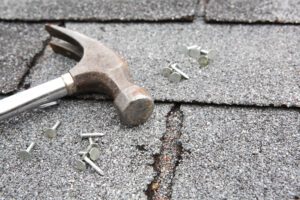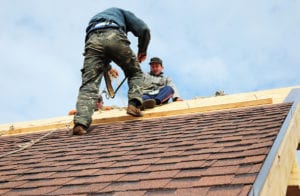
Are Leaking Roofs Covered by Homeowners Insurance?
When you discover a leak in your roof, one of the first questions that likely comes to mind is, “Will my homeowner's insurance cover roof leaks and the cost of roof repair?” The answer is often nuanced and depends on several factors. Understanding your insurance policy and its implications for roof damage can help you make informed decisions when your roof needs to be repaired.
Understanding Your Home Insurance Policy
The purpose of a home insurance policy is to provide financial protection against unexpected damage or loss to your property. However, not all types of damage are covered. It's crucial to familiarize yourself with your policy to know what is and isn't included.
Most standard homeowners insurance policies provide coverage for certain perils, or causes of loss, such as fire, wind, hail, and other weather-related events. If your leaky roof is the result of one of these covered perils, your insurance will likely cover the cost of roof repair.
When Does Homeowners Insurance Cover Roof Leaks?
Insurance companies often base their decision on the cause of the roof damage. If the leak was caused by a sudden, unexpected event like a windstorm, hailstorm, or falling tree, the roof repair would typically be covered under your policy.
(If you have downed branches from a storm you need to cut, check out our HaxSaw Review.)
For example, if a severe hailstorm damages your shingles, leading to a roof leak, your insurance company would likely cover the cost of repairing the damage. Similarly, if a tree branch falls and punctures your roof during a windstorm, causing a leak, this would also typically be covered.


When Is a Leaky Roof Not Covered?
Conversely, if the roof damage is due to wear and tear or lack of maintenance, the insurance company will likely deny the claim. Homeowners' insurance policies generally do not cover damage resulting from neglect or failure to properly maintain the property.
For instance, if your roof has been deteriorating over many years and you've ignored missing or damaged shingles, an insurance company would likely consider this a maintenance issue. If a leak develops as a result, it would not be covered by your insurance.
Other Factors to Consider
- The age and type of your roof may also affect your coverage.
- Some insurance policies offer less coverage for roofs over a certain age or may only cover the actual cash value of the roof at the time of loss, rather than the cost of a replacement.
- It's essential to read your policy carefully and ask your insurance agent about any exclusions or limitations.
Understanding your coverage can help you manage your expectations if a leak occurs and prevent any unpleasant surprises.
Whether or not homeowners insurance covers roof leaks depends on the cause of the damage. While insurance typically covers unexpected, unavoidable damage from perils like storms, damage from neglect or lack of maintenance is not usually covered. To protect your home and your wallet, keep your roof in good repair and understand your insurance policy.
How to Handle a Leaking Roof
Discovering a leaking roof can be stressful. However, knowing how to handle the situation promptly can prevent further damage and potentially save you money. Here are some steps to take if you discover a leak:
Identify the Source of the Leak
Firstly, it's crucial to identify the source of the leak. Look for water stains, mold, or other signs of water damage in your attic or upper floor. If you can see the leak source, it will be easier to explain the problem to your insurance company or a roofing contractor.


Contact Your Insurance Company
Once you've identified the leak, contact your insurance company as soon as possible. If the damage is due to a covered peril, like a storm or falling tree, they will guide you through the claim process. It's important to provide detailed information about the damage and how it occurred.
Hire a Professional Roofer
The next step is to hire a professional roofer to assess the damage and provide an estimate for the cost of repair. Be sure to hire a reputable company with experience in dealing with insurance claims.
When choosing a roofer, consider the extent of the damage and the type of roof you have. For significant damage, or if your roof is nearing the end of its lifespan, you may want to consider a new roof.
Implement Temporary Measures
While you're waiting for the roofer, you should implement temporary measures to minimize further damage. This could include using a tarp to cover the affected area or placing a bucket under the leak to catch water.
Document the Damage
Take photos of the damaged area and any resulting water damage inside your home. This documentation can provide essential evidence when making an insurance claim.
Maintain Your Roof
Prevention is the best way to avoid a leaking roof. Regular maintenance can prolong your roof's lifespan and reduce the likelihood of leaks. This includes regular inspections, cleaning gutters, and replacing damaged shingles or tiles promptly.
Dealing with a leaking roof can be stressful, but taking prompt action can mitigate the damage and potentially save you money in the long run. Always consult with a professional to ensure your roof is properly repaired, and remember to maintain your roof to prevent future leaks.
How Do You Find a Roof Leak?
Identifying a roof leak isn't always as straightforward as spotting a puddle on your floor. Sometimes, the signs can be subtle and easily overlooked. Here are some tips on how to find a roof leak:
- Inspect Your Attic – Your attic is the first place you should look when trying to find a roof leak. During a sunny day, turn off the lights in your attic and look for sunlight coming through holes in the roof. Alternatively, you can go to the attic during a rainstorm to see where water is getting in.
- Look for Water Stains – Water stains on ceilings or walls are a clear sign of a roof leak. These stains are usually brown or yellow and may be accompanied by mold.
- Check for Damaged or Missing Shingles – Damaged or missing shingles can allow water to seep into your home. Inspect your roof for curled, cracked, or missing shingles.
- Examine Your Gutters and Downspouts – Clogged gutters and downspouts can cause water to back up and seep into your roof. Make sure your gutters are clean and in good repair.


Signs Your Leaking Roof Needs Repair
Even a small roof leak can cause significant damage if left unattended. Here are some signs that your leaking roof needs repair:
Persistent Leaks
If your roof continues to leak even after you've taken temporary measures to stop it, this is a clear sign that it needs professional repair.
Growth of Mold and Mildew
If you notice mold or mildew growth on your ceilings or walls, this could indicate a roof leak. Prolonged exposure to moisture encourages mold growth, which can lead to health problems.
Damaged Shingles or Flashing
Damaged shingles or flashing are common causes of roof leaks. If you notice these signs, it's time to call a professional for repair.
Increase in Energy Bills
A leaky roof can lead to increased energy costs. Water intrusion can damage insulation, leading to heat loss in winter and cool air loss in summer.
Cost of Roof Repair
The cost of roof repair can vary widely, depending on the extent of the damage, the type of roof, and the region where you live. On average, homeowners spend between $300 and $1,100 on roof repair. However, major repairs or roof replacements can cost several thousand dollars. It's important to get an accurate quote from a reputable roofing contractor to understand the potential costs. Remember, delaying repairs can lead to more significant damage and higher costs in the long run.
Factors That Affect the Cost of Roof Repair
Several factors can influence the cost of repairing a leaky roof. It's crucial to understand these factors so you can have a clearer idea of what to expect when it comes to repairing your roof. Here are some key factors:
- Extent of Damage
The extent of the damage is one of the most significant factors affecting the cost of roof repair. A small leak confined to one area will be less expensive to fix than widespread damage affecting multiple parts of the roof.
- Roof Material
Different roofing materials come with different costs for repairs. For example, asphalt shingles may be less expensive to repair than metal or tile roofs. The cost of materials and the complexity of the repair work can influence the overall cost.
- Location and Accessibility
The location of your home and the accessibility of your roof can also impact the cost of repairs. If your home is in a location where labor costs are high or if your roof is difficult to access, the cost of repairs may be higher.
- Cause of the Leak
The cause of the leak can also affect the cost of repairs. If the leak is due to poor maintenance, the repair may be relatively straightforward and less costly. However, if the leak is due to a structural problem or a natural disaster, the repair could be more complex and expensive.
- Age and Condition of the Roof
The age and overall condition of your roof can influence repair costs. Older roofs or those in poor condition due to lack of maintenance may require more extensive repairs or even a full replacement.
- Insurance Coverage
Your insurance provider may cover some or all of the cost of the repairs, depending on the cause of the leak and your policy's terms. However, keep in mind that insurance may not cover damage due to poor maintenance or wear and tear.


Remember, while cost is a significant factor, choosing the cheapest repair option may not always be the best course of action. Prioritizing quality and professional workmanship can prevent further leaks and potential damage in the future, saving you money in the long run.
When Homeowners Insurance Covers Roof Leaks
Generally, homeowners insurance covers roof leaks and other damages that are caused by “open perils” or “named perils” listed in your policy but some policies do have coverage limits. This is dependent on your insurance products limitations. Coverage usually includes unexpected and sudden incidents like fire, vandalism, or hail damage.
Hail Damage
Hail can cause significant damage to your roof, leading to leaks. If a hailstorm damages your roof, your homeowner's insurance policy will typically cover the cost of repairs or replacement. However, it's important to note that your insurer may only cover the depreciated value of the roof if it's old, rather than the full replacement cost.
Natural Disasters
Natural disasters such as hurricanes, tornadoes, or heavy winds can cause severe roof damage leading to leaks. Most standard homeowners insurance policies cover these “acts of God,” but it's always advisable to check your policy or speak with your insurance agent to understand your coverage.
However, some natural disasters, like earthquakes and floods, are not typically covered by standard home insurance policies. You might need to purchase additional coverage if you live in an area prone to these types of disasters.
The Importance of Roof Inspection
Regular roof inspections are crucial in maintaining your roof's health. An inspection can identify potential issues before they become significant problems, thereby potentially saving you from costly repairs or replacements. It also gives you documentation of your roof's condition, which can be helpful if you ever need to file an insurance claim.
Remember, home insurance policies generally do not cover roof damage resulting from neglect or lack of maintenance. Regular inspections and timely repairs can help ensure your roof remains in good condition and that leaks or other issues are addressed promptly.
Understanding whether or not homeowners insurance covers roof leaks can be a bit complex, as it often depends on the cause of the leak. Events like hail damage and other natural disasters are typically covered, while leaks due to poor maintenance may not be. It's always advisable to thoroughly read your insurance policy and consult with your insurance agent to understand your coverage. Regular roof inspections and maintenance can help keep your roof in good shape, potentially saving you from costly repairs in the future.

Leave a Reply